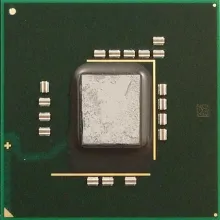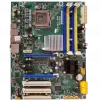
The Intel P45 is a Northbridge chipset designed for desktop motherboards, introduced by Intel in 2008 as part of the Intel 4 Series chipset family. It was developed to support Intel Core 2 processors, providing a platform for mid-range and high-performance desktop systems. Here's a comprehensive overview in 300 words:
The Intel P45 chipset, fabricated on a 65nm process, succeeded the P35 chipset and brought several enhancements. It supported the front-side bus (FSB) speeds of 800, 1066, and 1333 MHz, catering to a range of Intel Core 2 processors. The chipset featured the Memory Controller Hub (MCH) and the I/O Controller Hub (ICH10) architecture, dividing memory and I/O functions.
Key features included support for DDR2 and DDR3 memory, allowing flexibility for motherboard manufacturers and users. DDR2 memory operated at speeds up to 1200 MHz, while DDR3 memory, a newer and faster technology, could reach speeds of 1600 MHz.
The P45 chipset provided support for dual-channel memory configurations, enhancing memory bandwidth for improved system performance. It also featured Intel's Fast Memory Access and Flex Memory technologies, optimizing memory utilization and enhancing overall system responsiveness.
In terms of graphics support, the P45 was designed to work with discrete graphics cards, supporting multiple PCI Express x16 slots for scalable graphics configurations, including CrossFireX for AMD GPUs.
Storage capabilities included support for SATA 3.0 Gbps (SATA II) interfaces, providing high-speed connectivity for hard drives and optical drives. The ICH10 component of the chipset facilitated USB connectivity, audio, and other I/O functions.
The Intel P45 chipset was known for its reliability and stability, making it a popular choice for mid-range to high-end desktop systems during its era. Its compatibility with a range of Intel processors and support for both DDR2 and DDR3 memory options contributed to its versatility. While it has been succeeded by newer chipsets, the P45 remains a part of computing history, representing a stage in the evolution of Intel's chipset technology.
